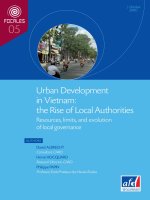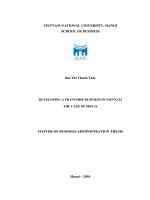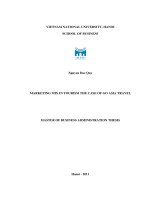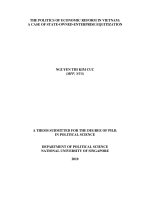Removing cumbersome in financing scientific research in universities in Vietnam the case of academy of finance
Bạn đang xem bản rút gọn của tài liệu. Xem và tải ngay bản đầy đủ của tài liệu tại đây (187.01 KB, 11 trang )
JSTPM Vol 2, No 2, 2013
33
REMOVING CUMBERSOME IN FINANCING SCIENTIFIC
RESEARCH IN UNIVERSITIES IN VIETNAM
THE CASE OF ACADEMY OF FINANCE
M.Sc. Pham Lan Anh
Academy of Finance
Abstract:
In recent years, the Government has implemented a number of policies with specific
measures for promoting science and technology (S&T) development. However, reality
shows that financial investment for S&T activities is still far from expected to meet the
requirements of industrialization and modernization of the country. S&T needs large
financial investment while the resource allocated for S&T from the State budget is limited.
In this difficult context, we have not had, on the other hand, appropriate policies and
mechanisms strong enough to mobilize other non-state funding sources, encourage all
economic sectors to invest in science and technology, especially in technology application.
Particularly, the issue of finding solutions to overcome difficulties in universities caused by
financing mechanism for scientific research is essential to ensure successful contribution of
S&T to the country’s industrialization and modernization. In this paper, the author pointed
out achievements, constraints and the need of provision of appropriate intervention
measures to overcome cumbersome in the current financial regime for scientific research in
universities. Especially, the author proposed groups of solution with a view to improving
the financing mechanism for S&T in universities, in general and in the Academy of
Finance(AOF), in particular.
Keywords: Finance for S&T activities; Financial mechanism; University.
Code: 13081501
1. Introduction
Science and scientific research is a means of fostering economic
development, social progress and has been playing an important role in
socio-economic development of each nation, particularly for Vietnam. In
past years, the Government has implemented a number of policies with
specific measures for promoting science and technology (S&T)
development. However, it was not as expected as the assessment stated in
the Resolution of 2nd Conference of the Party Central Committee, term VII,
on strategic orientation for S&T development in the period of
industrialization - modernization and specific S&T tasks up to 2015, says:
“we have not had appropriate policies and mechanisms to mobilize other
non-state funding sources for S&T development...”. Reality shows that
34
Removing cumbersome in financing scientific research…
financial investment for S&T activities is still far from expected to meet the
requirements of industrialization and modernization of the country. S&T
needs large financial investment while the financial resource allocated for
science and technology from the State budget is limited. In this difficult
context, we have not had, on the other hand, appropriate policies and
mechanisms strong enough to diversify the way of mobilizing other nonstate funding sources, encourage all different economic sectors to invest in
science and technology application.
For a higher education institution, teaching and scientific research are two
basic interrelated and interactive tasks, they are complementary, it may
promote or hinder the development of each other. To improve the quality of
education and training, each teacher must constantly improve the quality of
curriculum by doing research, applying scientific research results in
teaching and learning. One of the factors affecting scientific research
activities of the faculty members is financial mechanism. In practice, there
have been many research works on financial mechanism for scientific
activities in universities and the way to use effectively the resource allocated
to them. The case study of AOF gives us some lessons learnt from the
current financial regime for scientific research in general and for research
activities in universities, in particular. It also suggests that this issue should
be continued to study deeper.
Some key concepts used in this article.
S&T activities is: a system of interrelated activities closely related to the
production, improvement, dissemination and application of science and
technology knowledge in all fields of science and technology, i.e., natural
sciences, engineering and technology, medical sciences and agriculture, as
well as social sciences and humanity (defined by UNESCO).
Scientific research is an activity to detect, understand phenomena, objects,
natural laws, social and thinking; innovative solutions for application in
reality. Scientific research includes basic research and applied research.
2. Present situation of the financial mechanism of Vietnam for scientific
research in universities
There are many approaches to analyze the financial resources for scientific
research in universities. In this article, the author uses the approach of
comparison between direct funding from the State budget and by other
financial resources for analysis. The reasons for using this approach are as
follows:
JSTPM Vol 2, No 2, 2013
35
-
Currently, funding for S&T from non-state sources in our country is
still not common. Private companies have almost had not much
investment in scientific research. Funding of State-own enterprises for
S&T is not considerable and mostly comes from State budget, by
nature.
-
In reality, finance for S&T in universities is mainly from State budget,
if some research projects the university signed contract with
provincial/city authorities or businesses, most of the funding also has
the origin of the State budget.
-
Financial support by foreign organizations for S&T looks significant in
recent years but due to lack of statistics, it is difficult to track records.
In pursuant to the State policy of socialization, diversification of capital
sources for S&T development, financial resources invested in this sector are
increasingly expanding and it attracts the involvement of all economic
sectors, both domestic and foreign:
-
Financial resources from the State budget directly allocated to
scientific research in universities include: State Development Fund
managed by the Ministry of Planning and Investment; State scientific
research programs or tasks; Funding allocated for S&T development at
ministries, provinces, cities, and from there channeled to universities.
-
In addition, other financial resources for scientific research in the
universities can include: Sale of experimental products such as seed of
crop varieties, livestock, prototype machine and equipment to be used
in production; extra income from research contracts, training services,
rent of technical facilities; part of tuition fee collected, support of
international organizations through collaborative research projects.
3. Assessment of the effectiveness of the financial mechanism for
scientific research activities in universities
3.1. Achievements
-
Thanks to the increased investment of the State in building basic
infrastructure of universities and funding for scientific research
activities, the conditions for training/education and scientific research in
universities have been much improved, better meeting the requirement
of learning, teaching and scientific research.
-
Teaching staff at universities is increasingly getting empowered with
qualifications improved and more experienced. Every year, hundreds of
teachers in universities receive PhD and Master degree, or granted with
Removing cumbersome in financing scientific research…
36
associate professor and professor title. This means, an additional force
of highly qualified teachers has been added to undertake training and
research activities.
-
Universities have made a number of significant contributions to the
country’s industrialization and modernization through carrying out
scientific research programs at State or Ministry level, and through
transfer of knowledge and technology and utility solutions for the
country's socio-economic development.
-
Contribution of university can be made for planning, policy making and
guidelines of the Party and State: research programs and projects has
provided scientific arguments and foundation for the preparation,
elaboration of plans, guidances and policies for national socioeconomic development and management, science and technology
development, improved product quality, enhanced competitiveness of
businesses and the economy, increased development level of productive
forces.
3.2. Restrictions
Besides the achievements mentioned above, the financial regime for
scientific research in universities exposes some limitations as follows:
-
Investment in scientific research in universities is not highly effective
because research activities have not much impact on empowerment and
development of teaching staff.
-
Level of funding from the State budget per teacher is still lower than
required by research and staff empowerment tasks.
-
Fund allocation mechanism in the financial regime for research
activities is still unreasonable, still on average basis.
Causes of the restrictions:
First, in the condition that the State budget is still limited, the spread and
irrational budget allocation for scientific research makes it insufficient
investment in science and technology projects in universities.
Second, lack of mechanisms and policies and diversified forms of
mobilizing financial resources outside the State budget for scientific
research and technology transfer.
Third, lack of coordination between financial sources for scientific research
and funding for education/training in universities.
Fourth, lack of mechanisms for effective use of funds from the State budget
for scientific research in universities.
JSTPM Vol 2, No 2, 2013
37
Fifth, loose relationship between universities (researchers), research result users
and State in the mobilization and use of financial sources for S&T activities.
4. Actual situation of the financial regime for scientific research in the
Academy of Finance
Annual budget of the Academy is allocated from the State budget: VND 3
billion for 2012, VND 3.5 billion for 2013 against VND 3.9 approved for
the year. However, it was still far from the requirement for scientific
research activities in order to complete the scientific research process from
conducting research, testing and practical application.
Regarding research and teaching equipment, annually the Academy makes
investment in necessary procurement of equipment to best meet the
requirement of teaching and scientific research of faculty members.
Currently, the Academy has 285 desktops; 281 air conditioners, 291
printers, 92 projectors of all kinds, 3 scanners, surveillance camera systems,
and peripheral equipment, namely super speed printers, fax machines, audio
system, lighting systems in auditorium for lecturing, seminar, exclusive web
pages on the Internet and various software applications for managing
research projects and the Academy’s library. In coming years, AOF
continues to strengthen, expand and upgrade its technical facilities to meet
the needs of teaching and scientific research of faculty members.
Over the past 45 years, the Academy completed total 586 research projects,
including 3 national-level projects, 141 projects of Ministry level, 442
research themes of Academy level.
In addition to research projects funded by the Academy, individual units,
scientists have also signed contract with outsiders or got involved in
research projects funded by other financial sources.
Content of research projects mainly focused on improving the quality of
training, fostering the innovation of curriculum, education programs to be
appropriate to various kinds of trainees; elaboration of theoretical basis for
administrative science development in line with the requirement of
administrative reform.
The number of faculty members involved in research was 184 times. On
average, each faculty members took part in 2.4 projects in 5-year. Especially,
in past years, attention was paid to the involvement of students in research
activities with the funding support from the Academy in the range of VND
30 to 40 million/topic/year (about 12 topics/year). Scientific research
activity of the Academy has achieved certain results, made a significant
contribution to solving scientific theoretical concern in finance area,
38
Removing cumbersome in financing scientific research…
theoretical and practical issues in the field of state administrative
management, improving the quality of teaching in the Academy and the
improving the quality of the Academy staff, particularly proposing a number
of solutions to remove barriers in financial policies reform.
However, the AOF had faced many obstacles caused by the financial regime
for scientific research, e.g.:
The financial management is slow reform, still heavily subsidized, most of
expenditures of S&T activities still requires full budget from government,
though other sources are of high potential but have not been utilized to
reduce subsidies. Many specialized research projects have no specific cost
norms making it difficult in budgeting, allocation, disbursement and control
of project funds. Set of criteria for budget allocation of S&T is unstable,
lack of autonomy and flexibility and fairness between clusters of topics.
The reform of financial management is slow, not consistent with actual
changes. Many expenses need to be incurred but done without guidelines, it
made the spending ineligible. The allocation of State budget for S&T was
often late, not open/transparent, lack of discipline, violations of the state
budget law still happened.
5. Solutions for solving problems in the financial regime for scientific
research in universities in Vietnam
Facing the difficulties in following financial regulations for research in
universities in Vietnam, we need to have solutions for the problem:
First, to increase the level of funding for scientific research: Although
funding for scientific research in our country is not too low compared to
some other countries, it should be allocated in a more reasonable and
focusing manner to ensure effective use of the resource. For universities, we
need to scarify or cut down some of unnecessary funds to give it to
scientific research.
It can secure some more funds from domestic and international research
financing organizations such as: National Foundation for Science and
Technology Development (NAFOSTED) established since 2008; Technological
Innovation Fund established in 2011; The Teaching and Research
Innovation Grant project funded by World Bank (TRIG). This project has
allocated USD 60 million for 22 universities in 2008.
In addition, there are a number of funds available we need to look for the
opportunity to receive their support...
Second, there should be a reasonable allocation policy: According to the
guidelines of Ministry of Science and Technology, distribution of funds for
JSTPM Vol 2, No 2, 2013
39
the country's S&T development should focus on oriented basic research,
technology applications, research for policy, strategy formulation, research
for public services and science and technology of priority to encourage
researchers.
Third, increased autonomy in scientific research: Financial autonomy in
scientific research is very important. It encourages researchers be more
proactive in their own jobs. Financial autonomy must be linked to
accountability and transparency of information. Financial autonomy itself
does not create quality and efficiency, it is only a condition to create
enabling environment for the research, here the role of successful teams,
their dedication and quality scientists is more essential.
However, financial autonomy creates space for expansion and increase of
resources. It is good but we need, on the other hand, to prevent the right is
abused, arbitrarily used and then bring about serious consequences.
Financial autonomy is always tied with accountability of responsible
persons.
Fourth, promoting socialization policy in scientific research: Socialization
in scientific research is a very successful solution, right tendency if we
know how to handle it. We need to quit thinking of relying on the State
support and subsidy with a view to establishing closer link with the private
sector in scientific research.
Fifth, generating more funds for scientific research: This is very important
but should be done in a dynamic and creative manner. Scientific products
can be commercialized to get the return to research activity. Enhanced
linkage through contract with other institutions forwards making research
products become quality commodities for society.
6. Solving problems in financial regime in the Academy of Finance
The financial regime for scientific research in AOF should touch upon the
issue of autonomy; here autonomy means three aspects: academic
autonomy, financial autonomy and autonomy in organization of research
and personnel involved.
6.1. Academic autonomy
Academic autonomy is understood as autonomy in curriculum development,
training content, training inputs and mode of enrollment. In this respect, the
AOF as well as many other universities, in addition to comply with the
program framework, general content of some subjects stipulated by the
Ministry of Education and Training, the Academy has demonstrated its pro-
40
Removing cumbersome in financing scientific research…
activeness in localize other specific content. For example, some specialized
"spearhead" subjects have been designed by the Academy itself for the
professional courses in accordance with the training objectives of the
Academy [8].
However, the compliance with the framework of the Ministry of Education
and Training has exposed many limitations to the academic autonomy of the
Academy. Moreover, the enrollment norms as well as the right to open new
areas of study are still in status of "ask-give" mechanism. Accordingly, the
Academy is automatically placed under the management of two ministries:
Ministry of Finance and the Ministry of Education and Training.
6.2. Financial autonomy
Financial autonomy means self-securing and use of property of the
university. This is the leading factor to ensure the university can implement
its mission. Financial mobilization can be realized from many sources:
tuition fees, research funds from the State, from business sector, from
consulting services, from international cooperation, etc.
Currently, AOF is among a few universities having high budget coming
from the State. This source is guaranteed partly for regular expenses of the
Academy. However, only with this, the Academy cannot, even in the long
run, be fully self-financed or at least partly self-financed for its regular
budget.
The following issues need attention to be paid:
First, due to being bound by the tuition fee frame set forth by the
Government, the revenue of universities is limited.
Second, revenues from technology transfer activities and services of the
Academy is almost insignificant. Research and consulting programs under
contract with businesses and other organizations have not been
systematically promoted in the Academy.
Third, revenues from international co-operation also accounted for very
small portion in recent times. The Academy has been too slow to exploit
this potential source. The reason for this is lack of a mechanism to promote
the cooperation and competent staff for this activity.
Fourth, revenues from training and consultancy services are not much due to
low efficiency in implementation. According to the recent report, the average
net income from these operations was approximately VND 500 million.
Fifth, income generated from the internal services organized is not
significant. AOF has not organized a company to exploit “internal market
JSTPM Vol 2, No 2, 2013
41
for sutdent” namely cantina, library, sale of textbook, foreign languages
training, information technology,.... .
Sixth, the financial management system needs further improvement to assist
the Academy to identify which activities are effective and which are not.
6.3. Autonomy in organization of research and personnel involved
Indicative figure for enrollment was approved by the Ministry of Finance
based on the proposal of the Academy. Planning of human resources
development, staff recruitment, training, personnel utilization, management
is under decision of the Academy, except the appointment of leaders by the
Ministry of Finance.
Thus, it can say that this kind of autonomy has worked well by the Academy
and it has assumed clear "self-responsibility" though it looks on appearance
that the Academy is dependent on the Ministry of Finance. To be more
successful, the remaining problem in this autonomy of personnel
management, organization that needs to be solved is building the Academy
management machinery in a maximum decentralized manner by giving
more authority to the units in the Academy [11].
6.4. Solution for the autonomy and self-responsibility issue of the
Academy of Finance
To elaborate a development strategy with clear objectives is important and
indispensable for achieving autonomy of a university. In this respect, AOF
should define its own strategic objectives to be a leading university, in
which achieving autonomy goal is a means to reach strategic objectives.
From that mindset, we believe that the goal of autonomy is long-term goal,
it should be carried out through several stages:
-
Stage 1: Increased self-financing to the highest level towards full
autonomy in regular expenditure; step by step achieving autonomy in
academic;
-
Stage 2: Full autonomy in academic and administration model, internal
organization. This objective will not be completely achieved if state
institutional reform for universities unchanged.
First, the AOF should build up, at soonest, a business model for this matter.
In this model, we need to determine clearly the stable number of students,
stable number of teachers and management staff, the standards for a stable
infrastructure. On that basis, it can determine fixed and variable costs for
one trainee.
Removing cumbersome in financing scientific research…
42
Second, AOF need to seek investments for training services through various
forms. Different institutions can be established within the Academy or the
Academy can joint venture with other outside organizations of high
reputation by giving counterpart in-kind contribution (the Academy brand)
to increase competitiveness.
Third, the AOF should ask the State to allow the Academy be flexible in the
use of revenues from tuition fees credited in the bank account instead of
having to debit all to the State Treasury.
Fourth, it needs to use effectively the Academy’s brand and infrastructure,
good location to increase the revenue from the Academy services.
Finally, the Academy needs to promote scientific research, publication and
associated training services, international recruitment to raise income,
ensure the quality up to standards.
7. Conclusions and recommendations
7.1. Conclusions
The paper presents the need, the current situation and possible solutions to
overcome the cumbersome in the financial mechanism for funding scientific
research in universities in Vietnam in general and in the AOF, in particular.
The article pointed out achievements, constraints, the need of having
measures to overcome the bottlenecks in the financial regime for scientific
research in universities. On the basis of recommendations for a improved
mechanism with a view to better and effective mobilization and use of
financial resources, the author suggested a cluster of solutions to complete
financial mechanism for S&T in universities of Vietnam in coming years.
For a more in-depth paper, the author will continue to conduct further
studies to produce other article to express a reflection that not only in higher
education sector but also in other sectors, financial regime always exposes
"bottlenecks" that should be overcome and removed.
7.2. Recommendations
1.
First, it should create an institutional environment to enable scientific
research products become commercialized, traded between scientists
and entrepreneurs.
2.
Second, the support to the scientific and technological market and
relevant regulations of the State should be strengthened.
3.
Third, funding sources to support research organizations and tax
incentive policy for them should be revised and updated.
JSTPM Vol 2, No 2, 2013
43
REFERENCES
1.
Government. (2003) Decree No. 60/2003/ND-CP dated 06/6/2003 of the Government
detailing and guiding the implementation of the State Budget Law.
2.
Prime Minister. (2004) Decision 171/2004/QD-TTg dated 28/9/2004 approving the
project on reform of science and technology management mechanism.
3.
Ministry of Finance - Ministry of Science and Technology. (2006) Joint Circular No.
04/10/2006 dated 93/2006/TTLT/BTC-BKHCN Guide mode funding package
assignment of topics, science projects and technologies using state budget.
4.
Ministry of Finance - Ministry of Science and Technology. (2007) Joint Circular No.
44/2007/TTLT-BTC-BKHCN dated 07/5/2007 guiding the construction of cost norms
and budget allocation for science and technology projects using state budget.
5.
Ministry of Education and Training. (2008) Decision 64/2008/QD-BGDDT of the
Minister of Education and Training dated 28/11/2008 on working regime of lecturers
in Universities.
6.
Academy of Finance. (2003) Finance for of science & technology development.
Proceedings of Workshop, Hanoi, March 2003.
7.
Vu Duy Hao .(2005) Improving the financial management in public universities of
Vietnam. Research theme at ministerial level B2005.38.125.
8.
Vu Thi Hien. (2005) State S&T management reform in Vietnam today. Economic
Master thesis, National Economy University, Hanoi.
9.
Do Van Thang. (2006) Measures to ensure the research function of the University of
Social Sciences and Humanities, National University of Ho Chi Minh City. Master
Thesis in Science and Technology Management.
10. Vu Cao Dam. (2009) Collection of published works. Volume 1: Science Theory and
Methodology. H.: Su that Publishing House.
11. Le Huy Duc. (2010) Solutions for effective use of 1% of the annual state budget for
science and technology activities in universities and colleges period 2006 -2010.
Report of the results of the key research project at Ministry level.
12. www.hvtc.edu.vn









